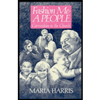The title of Maria Harris’ work, Fashion Me a People: Curriculum in the Church (Louisville: Westminster/John Knox Press, 1989), engages the reader from the outset. Here is a work about the Church claiming its identity as the people of God to live out its pastoral vocation. Anyone who is passionate about being God’s people and the particular call “to end our isolation from others by living each day of our lives rooted …in the Christ,†will want to read, explore and most importantly engage this work. However, it is not a book for the pastor’s library or for the Christian educator’s resource shelf alone. It is a work that is written for reading together as the church community and is written to engage both clergy and laity. It is a book written to and for the church with sound theological reason and practical exercises, not only for group reflection but also for group participation.

Harris begins with an acknowledgment of “the first portrait of church curriculum,†found in Acts 2:42, 44-47. While the reader may consider her ideas new, her basis is found within the early church! From these passages, she identifies “the set of forms†which “is the core of the educational ministry of the church.†She expands the definition of curriculum to include “all the facets of the Church’s life,†and thereby enlarges the definition of education as well. Her poetic description of God’s creative force as art allows for imagining the Creator’s activity at work within God’s people and moves the reader from a narrowly defined view for whom and where Christian education takes place. Harris stresses that education is more than what occurs in Sunday School and that is not just for children only. Noteworthy is her expansion of the narrow definition of curriculum as “printed, published resources.†In her broader approach and reliance on the Acts passage, she grasps a fuller definition of curriculum to include all of the “forms through which the church educates, such as worship, proclamation, community, and service.â€
The book itself is well outlined and lends itself to the vital “fashioning†of God’s people. Part One speaks of the context of educational ministry with the crucial understanding that the church has both a pastoral and educational vocation. She unpacks her broader definition of “curriculum†by noting the historically broader use of the term within the church and the contemporary challenges that seek reclamation of the broader definition. Perhaps this first section is a bit redundant but understandable on Harris’ part to overemphasize that which has been under emphasized. Part Two follows with a breakdown of how the whole life of the church is curriculum, by identifying the curriculum of community, prayer, teaching, proclamation, and service. Here is where Harris offers a blueprint, a catalyst, for the reader to work with others in their particular communal setting. Part Three calls for planning of the “practice of fashioning†which is, claims Harris, an “artistic process.†The artistic work is then guided through an especially strong practice and reflection section found at the end of each of her chapters.
Harris meets her goal. She provides a “serious†but “understandable†work to engage both laity and clergy, thus reaching the total community. In her introduction, she notes that she desires her work to “provide the leverage we need to move toward a more vital educational understanding and practice.†The only way her work will provide the leverage we need is for us, the people of God — the church — to embrace this work and offer our community for the “fashioning†her title, and most importantly, God desires.
Reviewed by guest blogger: Deborah Carlton
